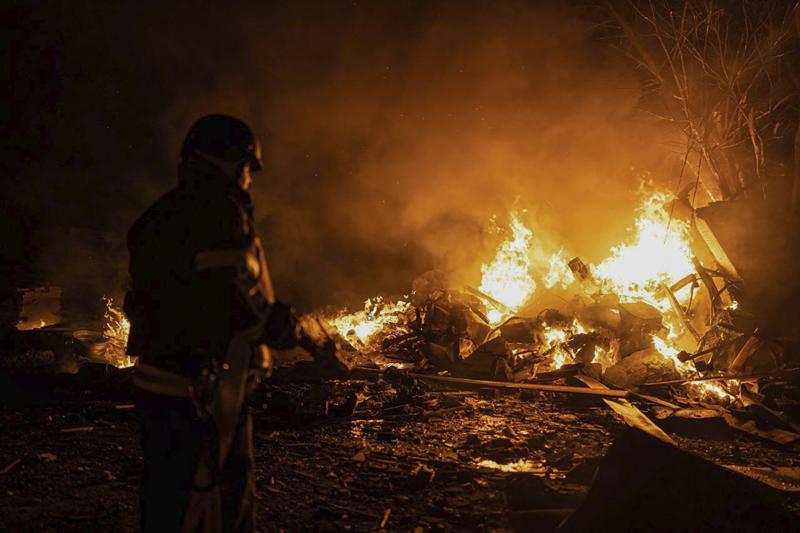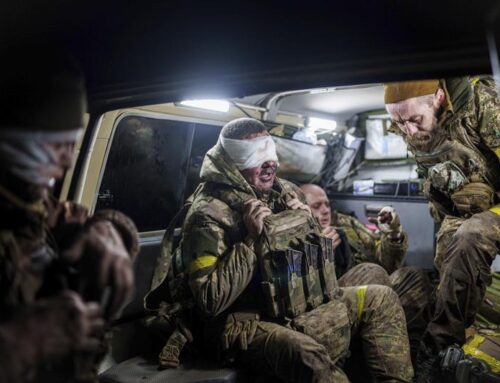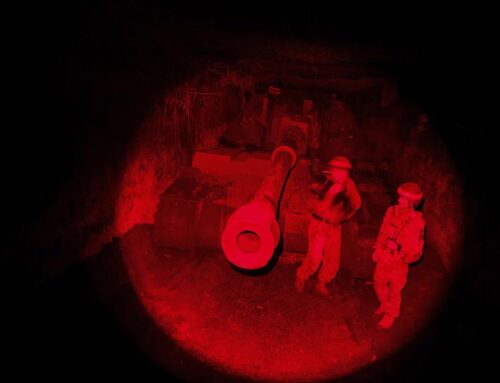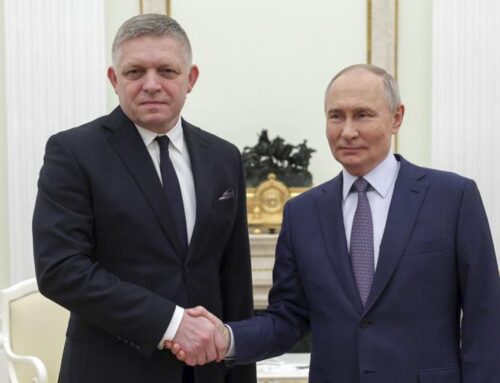KYIV, Ukraine (AP) — Ukrainian air defenses, bolstered by sophisticated Western-supplied systems, thwarted an intense Russian air attack on Kyiv early Tuesday, shooting down all missiles aimed at the capital, officials said.
The bombardment, which targeted locations across Ukraine, included six Russian Kinzhal aero-ballistic hypersonic missiles, the most fired in a single attack in the war so far, according to Ukrainian air force spokesman Yurii Ihnat.
Russian President Vladimir Putin has repeatedly touted the Kinzhals as providing a key strategic competitive advantage and among the most advanced weapons in his country’s arsenal. The missiles are difficult to detect and intercept because of their hypersonic speed and maneuverability.
If Ukraine’s claim of having shot down six fired Tuesday is confirmed, it would mark another blow to Putin’s war efforts and show the increasing effectiveness of the country’s air defenses.
Air force spokesman Ihnat, who said in March that Ukraine lacked the equipment to intercept the Kinzhals, didn’t explain Tuesday what systems were used to knock them down. Since March, Western countries have supplied Ukraine with various air defense systems.
Russia fired the Kinzhals from MiG-31K warplanes, along with nine cruise missiles from ships in the Black Sea and three S-400 cruise missiles launched from the ground, Ihnat said. In all, Ukraine’s military said later, Russia had targeted Ukraine with 27 missiles in a day and launched 37 airstrikes.
Russian Defense Minister Sergei Shoigu late Tuesday contested the Ukrainian claims, telling the state-run RIA-Novosti news agency: “We have not launched as many Kinzhals as they allegedly shoot down every time with their statements.”
Loud explosions boomed over Kyiv in the major nighttime attack apparently aimed at overwhelming Ukraine’s air defenses. Kyiv’s mayor reported three people were wounded.
The barrage came as European leaders sought new ways to punish Russia for the war and a Chinese envoy sought traction for Beijing’s peace proposal, which appears to have made little impression on the warring sides. It also came as Ukrainian President Volodymyr Zelenskyy returned home from a whirlwind European tour to seek more military aid.
The overnight attack on Kyiv was “exceptional in its density — the maximum number of attacking missiles in the shortest period of time,” said Serhii Popko, the head of the Kyiv military administration.
Kyiv resident Valentyna Myronets, 64, said she felt “pain, fear, nervousness, restlessness” amid the assaults. “God, we are waiting for victory and when all this is over,” she said.
U.K. Ambassador Melinda Simmons tweeted that the barrage was “pretty intense.”
“Bangs and shaking walls are not an easy night,” she wrote.
It was the eighth time this month that Russian air raids had targeted the capital, a clear escalation after weeks of lull and ahead of a much-anticipated Ukrainian counteroffensive using newly supplied advanced Western weapons.
After the first onslaught, Russia also launched Iranian-made Shahed attack drones and conducted aerial reconnaissance, Ihnat said.
Debris fell across several districts in the capital, starting fires, Kyiv Mayor Vitali Klitschko said.
Sophisticated Western air defense systems, including American-made Patriot missiles, have helped spare Kyiv from the kind of destruction witnessed along the main front line in the country’s east and south. While most of the ground fighting is stalemated along that front line, both sides are targeting other territory with long-range weapons.
Associated Press reporters saw a metal fragment that landed inside the Kyiv zoo labeled Lockheed Martin and Boeing, two of the companies involved in manufacturing the Patriot missile system.
Russian Defense Ministry spokesman Igor Konashenkov said a Kinzhal destroyed a Patriot missile battery in Kyiv but he didn’t provide evidence, and the statement couldn’t be independently verified. Ihnat, the Ukrainian air force spokesman, refused to comment on the claim.
Russia began using the Kinzhal to strike targets in Ukraine early in the invasion but has used the expensive weapon sparingly and against priority targets, apparently reflecting limited availability.
The Russian military says the missile’s range is up to 2,000 kilometers (about 1,250 miles) and it can fly at 10 times the speed of sound. Its speed and heavy warhead allow the Kinzhal to destroy heavily fortified targets, such as underground bunkers or mountain tunnels.
Ukraine’s bolstered air defenses have deterred Russia’s aircraft from going deep into the neighbor country and helped shape the course of the war, military experts say.
In Iceland, European leaders are taking part in a rare summit of the 46-nation Council of Europe, the continent’s main human rights body, to discuss how to manage claims for compensation from Russia’s damage to Ukraine.
Meanwhile, a Chinese envoy is preparing to visit Ukraine and Russia as Beijing advocates a peace plan it released in February. Li Hui, a former ambassador to Moscow, also will visit Poland, France and Germany, according to the Chinese foreign ministry.
Ukraine has cautiously welcomed China’s proposal while saying it would wait to see what specific actions China takes. Chinese leader Xi Jinping’s government says it is neutral and wants to mediate in the war, but has given Moscow political support, and a breakthrough appears unlikely.
In Russian-occupied southern Ukraine, about 500 kilometers (300 miles) from Kyiv, Russian officials began training to evacuate 3,100 staff members of the shut-down Zaporizhzhia Nuclear Power Plant and their families, a representative of Energoatom, Ukraine’s state nuclear company, said Tuesday.
The plant, Europe’s largest nuclear power station, employed around 11,000 people before the war, some 6,000 of whom remain at the site and in the surrounding town of Enerhodar.
More Russian military units have arrived at the plant and are mining it, the representative told The Associated Press on condition of anonymity because he was not authorized to speak publicly on the matter. Russian troops have barred remaining workers from communicating with each other or leaving, Energoatom said on Telegram.
In other developments:
—Ukrainian forces recaptured around 20 kilometers (7.7 square miles) of territory north and south of Bakhmut since last week, but Russian troops continue their grinding advance within the city, Ukraine’s deputy defense minister said Tuesday. “Heavy battles continue with differing results,” Hanna Malyar said on Telegram. The Russian-installed head of the partially occupied Donetsk region, Denis Pushilin, told Russian state TV that Russian forces near Bakhmut have reinforced their flanks in the face of Ukrainian successes.
—Ukraine’s intelligence chief made a rare acknowledgement Tuesday of his country’s involvement in assassinations of Russian officials. In an interview posted on YouTube with a Ukrainian journalist, Kyrylo Budanov responded to a question about the deaths of “Russian propagandists” by saying: “We have already got a lot of people.” He declined to provide any details.
— In Ukraine’s latest corruption scandal, which saw the head of the Supreme Court detained for alleged bribery on Monday, the chief of Ukraine’s National Anti-Corruption Bureau, Semen Kryvonos, identified the main suspect in the case as mining magnate Kostiantyn Zhevago. Zhevago was arrested in the French Alps in January on suspicion of embezzling tens of millions of dollars.
— South African President Cyril Ramaphosa said his Russian and Ukrainian counterparts have agreed to separate meetings with a delegation of African leaders to discuss a possible plan to end the war. Ramaphosa’s office said he spoke with Putin and Zelenskyy by phone over the weekend and they agreed to host “an African leaders peace mission” in Moscow and Kyiv, respectively.
___
Vasilisa Stepanenko in Kyiv, and Yuras Karmanau in Tallinn, Estonia, contributed to this report.
___
Follow AP’s coverage of the war in Ukraine at https://apnews.com/hub/russia-ukraine
This article first appeared on APnews.com







Leave A Comment